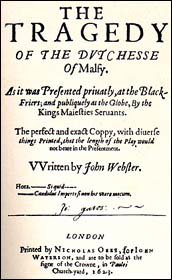John Webster

George Bernard Shaw dismissed him as a "Tussaud laureate"; but at the other end of the spectrum, T.S. Eliot saw him as a sensitive artist who "was much possessed by death/ And saw the skull beneath the skin," knowing that "thought clings round dead limbs/ Tightening its lusts and luxuries."
Little is known about the playwright John Webster (we don't even know the exact dates of his birth or death), but Tom Stoppard added considerably to his legend by portraying him as a blood-lusting child hanger-on in Shakespeare in Love. He was the son of a coachmaker, is likely to have studied law at the Middle Temple around 1597, and may have served as a clerk at St. Andrew's, Holborn. Although it is not believed that he toiled as a full-time writer, by 1602 he was contributing scenes to multi-authored plays such as Christmas Comes But Once a Year and Lady Jane.
After co-writing Westward Ho and Northward Ho with Thomas Dekker (1605), he churned out a few tragedies of his own before disappearing from the boards and from history: The White Devil (1612), his masterpiece The Duchess of Malfi (1613), The Devil's Law Case (1617) and Appius and Virginia (1622).
While some critics have found them to be implausible, gratuitously violent, cheap melodramas, Webster's works are classic examples of bloody, grim Jacobean drama. They're not really "revenge" dramas as much as they are pageants of swirling human evil and Hobbesian bleakness, put across by Webster in sure-handed verse, often with famously stark language. One of his more renowned lines from Malfi -- "Cover her face: mine eyes dazzle: she died young" -- has been described as a "three-act tragedy in miniature."
As for realism, Webster had no pretentions to it; his scenes are, like Renaissance street literature, woodcut tableaux inscribed with darkly moralistic couplets and decorated with grinning corpses.
Labels: Literature, Shakespeare, Theater





0 Comments:
Post a Comment
Subscribe to Post Comments [Atom]
<< Home